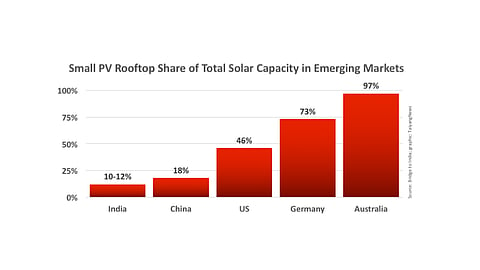

The Indian rooftop PV installation is to cross 1 GW of cumulative capacity by September 2016. While this is just a first step towards the government's ambitious 40 GW target by 2022, it means that the sector is growing by 300% over last year.
This rooftop solar segment is expected to add 700 MW of new capacity in 2016, which would be 15% of total solar capacity additions in the current year, according to clean energy consultancy Bridge to India. Expecting significant capacity addition in the commercial and industrial segment to come online before the end of this month, Bridge to India emphasizes that investors will be able to claim 80% of accelerated depreciation (AD). From the start of the next fiscal year, in April 2017, the Ministry of Finance has reduced the depreciation rate for its AD policy to 40%, but the consultancy expressed doubt if the AD benefit will be available for solar projects after this date.
Increasing government support for rooftop solar
The Indian government has been trying to improve support for installing rooftop PV in India over the last few months. Recently, the Solar Energy Corporation of India (SECI) announced 1,000 MW of solar rooftop PV to come up on government buildings (see SECI Rooftop Scheme For Government Buildings). The Ministry of New and Renewable Energy (MNRE) has also initiated a program to geotag all renewable energy projects with special emphasis on estimating potential for generating decentralized and distributed solar power by utilizing rooftop and other vacant land (see India Geotags PV Rooftop Projects).
The ministry provides a 25% subsidy for government buildings and has set targets for government departments for PV rooftop additions. It is also working on introducing a technical regulation to ensure the quality of PV equipment used under the Jawaharlal Nehru National Solar Mission (JNNSM) (see New Indian Quality Regulation for PV Equipment). MNRE is also working on making net metering policy more effective. Nevertheless, it is the private sector led by commercial and industrial consumers that are leading the demand in rooftop PV segment.
Comparing India with the rest of the world, Bridge to India says rooftop solar currently makes up 10% to 12% of the overall solar capacity additions in India. The government wants to reach a 40% solar rooftop share of the 100 GW installed by 2022. Its counterpart markets are already at a much higher rate, as the US with 46%, Germany 73%, China 18% and Australia 97%, according to Bridge to India.
The consultancy believes, "The high growth phase of India's rooftop solar market has only just begun. This market has got a great potential and it is very encouraging to see the government addressing some of the key challenges."
.png?w=50&fm=png)